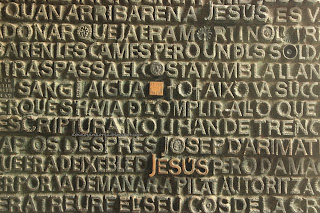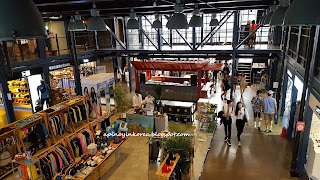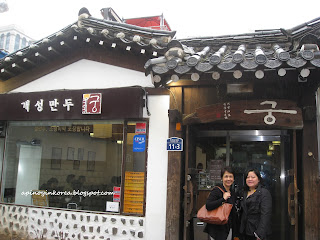That autumn day, a few years back, I was comfortably seated on a Barcelona tour bus, lazily wandering around the city, when I realized that the scheduled time on my ticket to go up the tower of Familia Sagrada was less than an hour away. (I purchased my ticket online before I arrived in Spain.)
(The towers came into view.)
The basilica of Familia Sagrada (Holy Family in English) is one of Barcelona's most popular tourist attractions, but being a Catholic, I wouldn't be just a tourist; I'd be a pilgrim. Designed by a Catalan architect, Antoni Gaudi, also known as God's architect because of his vision and work on the basilica, Familia Sagrada is one of the most beautiful buildings in the world. Gaudi died in 1926 after being hit by a tram in the streets of Barcelona.
Worried that I wouldn't make it in time, I carefully studied the city map on hand and decided to ditch the tour bus. So, when the West Route tour bus I was riding on made its scheduled stop at the La Pedrera, I got off and made a run for it. I could have transferred to the East Route bus but it would still meander through the city passing by several stops before arriving at the cathedral, while the La Pedrera bus stop was the nearest to the Familia Sagrada. As they say, the nearest distance from Point A to Point B is a straight line. Well, it wasn't exactly straight a line but it was the shortest cut just the same.
(Lo and behold! As I looked up from the
Plaça de la Sagrada Familia)
From the La Pedrera bus stop, I walked northeastwards for about 1.3 kilometers to reach the Familia Sagrada. And even though I knew my navigational skills were always better than a compass, I had to ask for confirmation along the way just to make sure I was on the right track. So, when I came across a bookstore along Carrer de Provença, and after buying una toda mapa de España (a map of Spain) from her, I asked the Spanish lady whether "esta direccion para Familia Sagrada" was correct. She confirmed,"¡Si!"😀
It wasn't long before the towers of Familia Sagrada came into view, and when I finally arrived at the cathedral grounds to join a thousand other tourists, I just showed my online reservation and got in easily.
(The spectacular center of the Nativity Facade
telling a Bible story that comes to life
with faith and adoration.)
The Nativity Facade faces east to be symbolically true to its meaning: the rising sun gives birth to life. It also has three porticos after three Christian values: Charity, Faith, and Hope.
(Familia Sagrada on their flight to Egypt
with an angel keeping them safe)
(The shepherds paying homage to the birth of Jesus)
While admiring Gaudi's work from the ground looking up, one reflects the passages from the Bible as they are depicted by one man's work that started in 1894 and was far from being complete when he died in 1926.
And as I stood there at the Nativity Facade that has been admired by millions of pilgrims and tourists, I added myself to that count.
At the entrance of the portico, I realized this was the most beautiful 'belen', or nativity scene, I have seen in my life. The life-like sculptures of the Holy Family, or Familia Sagrada, taking center stage, not only at the basilica named after their sacred union but at one's faith as well, is one portico of the cathedral not to be missed.
(The three kings bearing gifts)
(The nativity scene is the most popular Bible
story we bring to life. Which Bible story is this?)
(The rays of the sun passing through the stained glass was like peering through Mary's veil)
("Not too much light, nor too little...for both things blind and the blind cannot see." - Antoni Gaudi)
And to God's architect, Antoni Gaudi, eventhough his work is still being completed and is expected to be finished by 2026, a hundred years after his death, I join the millions of pilgrims, who have been awed, mesmerized and enlightened by a place of worship, in thanking him for making me realize that a most beautiful place of worship such as the Familia Sagrada could be possible here on earth.😂
So, from the Familia Sagrada in Barcelona, Spain, to our own families wherever we are, let's all celebrate to our being one with the Holy Family.💝
(JESUS prominently stands out among the words and passages written like a bas-relief type of artwork. HIS name is written in gold.)






















































